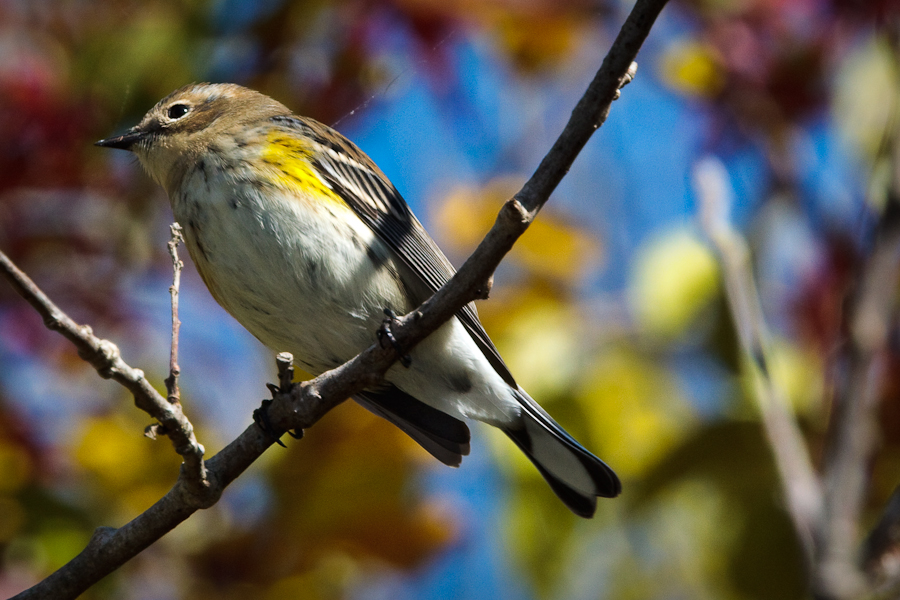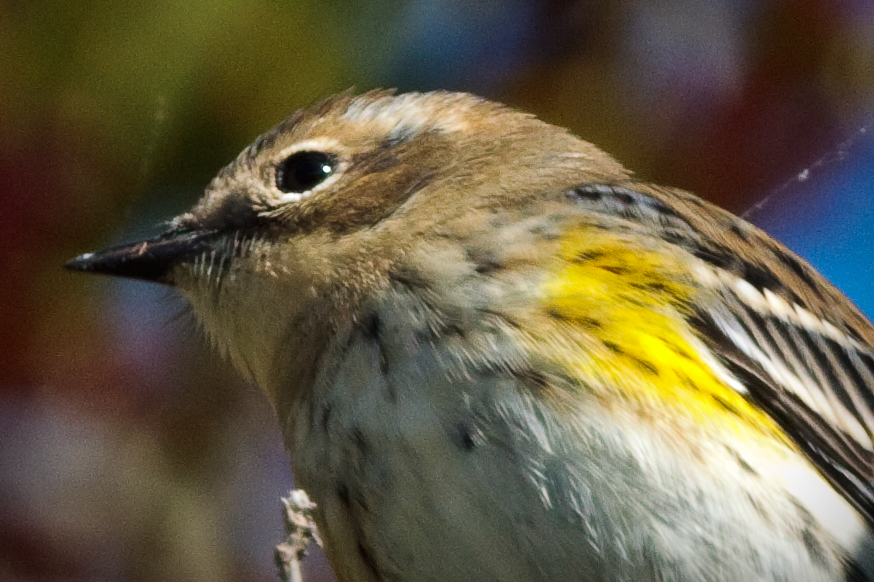Canon EF 70-300mm f/4.5-5.6 IS DO USM
This weekend I took the Canon EF 70-300mm f/4.5-5.6 IS DO USM out for a spin. The DO stands for “Diffractive Optics” which makes the lens a little sharper and a lot more expensive than the regular Canon EF 70-300mm f/4.5-5.6 IS USM lens. There were some nice photos like this Yellow-rumped Warbler:

However, it’s still not sharp enough for my taste, as seen when you zoom in:

If the photos were consistently this good, I’d probably settle for this lens; but they weren’t. Most were much less sharp than this. I shot mostly at ISO 400 and maximum aperture to push the shutter speed as fast as possible. Many of the photos came out looking fairly grainy. I haven’t noticed this before with the 50D, which usually does a fairly good job at higher ISOs. Next time I’ll try bringing the ISO down to 250 or so.
I should probably also try bringing the aperture down a stop or two to see if that increases the sharpness. From pure physics, sharpness should be maximized at the widest aperture (diffraction increases as the opening narrows) but in practice some lenses have aberrations in the glass such that they actually perform better with a slightly smaller aperture than their maximum. The additional depth-of-field might also help a bit with the autofocus, though that’s not nearly as critical as in macro work.
Update: after running some studio (OK, living room) tests, this lens does perform noticeably better at f/5.6 on 100mm. I’ll try that in the field this weekend. At 200mm, f/6.3 is better than f/5.6 though neither is as good as at 100mm. At 300mm, f/7.1 seems to be the sharpest though again less sharp than 100mm or 200mm.
I actually shot this warbler by using the built-in flash at only 1/250s (the maximum sync speed). One thing I don’t quite understand is why the slower shutter speed when using flash doesn’t cause problems. Typically you want at least 1/n seconds shutter speed for an n mm lens; e.g. 1/300s or faster for a 300mm lens. In practice I find that even with image stabilization I do better with much faster speeds than that, 1/4n or even faster. However most relatively close bird photos–i.e. warblers and other passerines as opposed to hawks and shorebirds–are taken with a flash, so next weekend I’m going to try this lens again with a 580EX II flash and see how much difference that makes.
Just maybe the 70-300 DO is good enough once I add the flash, but if not the next two lenses to try are the Canon EF 100-400mm f4.5-5.6L IS USM Telephoto Zoom and the Canon EF 300mm f/4L IS USM prime. I know at least one photographer who gets amazing results with the 300mm f/4 prime and a 1.4x teleconverter, so that may just be the way to go. Past that point, the lenses are just too heavy and expensive. (The Canon EF 400mm f/5.6L USM prime isn’t that much heavier or more expensive than the 300mm, but it doesn’t have image stabilization, so it doesn’t really work for the handheld shots I like.)

October 13th, 2009 at 2:34 PM
“From pure physics, sharpness should be maximized at the widest aperture (diffraction increases as the opening narrows) but in practice some lenses have aberrations in the glass such that they actually perform better with a slightly smaller aperture than their maximum.”
Theoretically, yes, but most if not all lenses perform best stopped down at least one or two stops, as you mentioned.